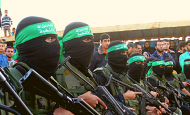HRW Does Not and Cannot Know Details of Gaza Airstrikes: Pseudo-reports as Propaganda
On August 23, 2021, Human Rights Watch (HRW) published its third (!) pseudo-report on the two-week armed conflict in Gaza and Israel, the latest titled “Gaza: Israel’s May Airstrikes on High-Rises.” Following its familiar trope, HRW alleges that Israeli actions “violated the laws of war and may amount to war crimes,” specifically concerning several incidents that have already been extensively covered in the media and by other NGOs.
At the time of the strikes, the IDF stated that the target buildings were an “important base of operations for Hamas’ military intel.” In addition to gathering intelligence, the statement refers to Hamas operatives in these buildings who “manufactured weapons and positioned equipment to hamper IDF operations.”
HRW laments that it does not have “the evidence” that the “Israeli military … says it relied on to carry out these attacks.” Indeed, without such information, the NGO cannot possibly comment meaningfully on the incidents. Instead, and consistent with the absence of credible research methodology and its invented legal standards, HRW’s “analysis” relies entirely on phone interviews with supposed Palestinian witnesses, as well as their attempt to interpret video footage and photographs taken on unspecified dates after the attacks.
Interviewed by phone?
HRW does not identify how its “witnesses” were selected, nor does it clarify whether or how it investigated possible witness affiliations to Palestinian armed groups. Similarly, HRW does not specify how it verified interviewee claims regarding the presence or lack thereof of combat activity or military infrastructure.
Additionally, HRW continues to erase the reality in Gaza, where Hamas controls information and regularly threatens retaliation against those who implicate the terror group in war crimes. For example, on May 13 Hamas issued a statement prohibiting Gazans from cooperating with individuals or organizations from outside of Gaza, announcing, “It is prohibited under all circumstances to provide details of events or to send messages and videos that discuss locations of bombing and its outcomes or rocket launching sites of the resistance.”
Indeed, even HRW’s own witnesses contradict its politically motivated conclusions. Accordingly, “One businessman said that Hamas had offices in Hanadi tower, but he could not identify who the tenants were or what they did, or that they had any links to Hamas’s armed wing.”
Despite these obvious and fundamental defects in reporting, HRW concludes that Israeli targeting of the towers and damage to adjacent buildings was “apparently unlawful” and, standard to all of its publications on Israel, that it “found no evidence that members of Palestinian groups involved in military operations had a current or long-term presence in any of the towers at the time they were attacked.” HRW’s consistent denial of the existence of Hamas terror tunnels and military installations, despite the extensive evidence, demonstrates that the organization is not engaging in credible research but rather engaged in disseminating propaganda.
Indeed, acknowledging the weakness of its allegations, HRW includes the caveat that “Even if there were such a presence, the attacks appeared to cause foreseeably disproportionate harm to civilian property.” Again, HRW provides no evidence to support this charge. Under international law, proportionality is assessed based on the expected outcome as perceived by the attacker at the time of the attack; essential information in this regard is possessed solely by the Israeli army and cannot possibly be known by HRW. Without access to detailed intelligence regarding Israeli targeting and damage assessments, HRW has no grounds for any conclusions regarding “disproportionality.”
Double standards
In its previous reports, HRW decried Israel’s alleged lack of precautions to minimize civilian casualties. In these airstrikes, Israel took steps to ensure zero casualties, neutralizing any such allegations. (As NGO Monitor has demonstrated, this is a complex issue, and HRW and other NGOs cannot possibly know whether an Israeli warning would compromise the military objectives of the attack.) Nevertheless, in their ongoing zeal to accuse Israel of wrongdoing, HRW’s leaders shift the focus to “damage to property.”
According to HRW, “…the attacks can be expected to have various “reverberating” effects – harm to civilians and civilian objects caused by the attack that are not direct or immediate. These include displacement and a reduced standard of living and impaired access to shelter, health care, and basic services such as electricity, all of which affect the enjoyment of basic human rights.” HRW then goes on to list ostensible dollar amounts of damage claimed by Gaza residents.
(Once again, HRW does not possess sufficient information to determine whether any such damage to civilian property is disproportionate or not.)
Notably, these very issues (harm to civilian objects and dollar amounts of damage) were completely absent from HRW’s reporting on Hamas rockets fired at Israelis. Evidently, HRW does not regard the “reverberating effects” of damaged incurred by Hamas rockets on Israelis as being worthy of actual research, and only discusses them in order to demonize Israel.
Hi-tech garble
HRW further claims that, in reviewing video footage and photographs, it was able to conclude “the use of munitions with large high-explosive warheads.” While this may sound significant and precise, in reality the generic term “high-explosive warheads” could refer to sophisticated cruise missiles, anti-tank rockets, or even artillery shells. The use of this generic term as if it was definitive again demonstrates HRWs complete lack of expertise in the realm of military technology and assessment. They also fail to explain how this information is relevant to assessing legality of military strikes.
Alleged “war crimes” investigations – immoral equivalence
Repeating a stock phrase used for many years, HRW claims that both Israel and Hamas, as the de facto authority in Gaza, have a duty to investigate allegations of serious violations of the laws of war. The image of a terror group investigating itself is inherently absurd, again highlighting the degree to which HRW’s activities on Israel reflect immoral equivalence. And although Israel has carried out multiple inquiries following outbreaks of violence in Gaza since December 2008, HRW cites its own fundamentally flawed and outdated 2010 document as supposed evidence of failing to “credibly investigate alleged war crimes…”
Like many such publications, this report is yet another blight on HRW’s credibility, and serves as part of an ongoing NGO campaign lobbying the International Criminal Court to target Israel for alleged “war crimes.”
For detailed information and analysis, see NGO Monitor’s “See No Evil: NGOs Turn Terrorists into Civilians in 2021 Gaza Conflict,” analyzing more than 50 incidents in which Hamas and Islamic Jihad combatants were incorrectly identified by Palestinian NGOs as civilians and in which Palestinian rocket misfires caused casualties and property damage.


